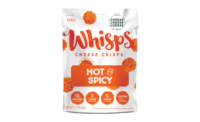![]()
More Cheese, Please...
by Kathie Canning
Today’s cheese ingredients boast a healthier reputation and a cornucopia of flavors.
We are a cheese-loving nation. The dairy delight tops our pizzas, adds pizzazz to our pasta and turns our ordinary sandwiches into gourmet delights.
According to the Wisconsin Milk Marketing Board, U.S. per-capita cheese consumption amounted to more than 30 lbs. in 2002. More than half of that cheese was devoured in foodservice offerings or in the pizzas, entrees and other refrigerated and frozen products gracing retail food cases.
Most of us, however, regard cheese as a flavorful indulgence packed with fat and calories. Although the product also is loaded with calcium and protein, we’ve been schooled to avoid it during weight-loss and other health promoting regimens.
Thanks to a spate of recent publicity that links cheese to a healthy lifestyle, however, the bad-boy reputation of this flavor-packed food is beginning to change. This reality, combined with a tempting array of flavor blends, could make cheese an even more attractive ingredient to food formulators — and push consumption levels to new highs.
Here’s to your health
Numerous studies link the calcium in three to four servings of dairy products with enhanced weight loss and body-weight maintenance. Other studies suggest that certain dairy-product components beyond calcium also play a role in body-weight regulation.
In one study, obese adults who consumed three to four servings of cheese, milk or yogurt on a balanced reduced-calorie diet lost significantly more weight and fat than those people who consumed equal amounts of calcium through supplements or who ate one or fewer servings of dairy products per day. In another study, adolescent girls lost weight and abdominal girth by adding just one dairy product to their diets.
The National Dairy Council is hoping to convince consumers to make cheese and other dairy products a larger part of a healthy diet. The council recently launched a major advertising campaign — “Healthy Weight with Dairy” — that touts the role of dairy in weight loss.
Cheese also fits in perfectly with today’s immensely popular low-carbohydrate diets.
“Historically, people have been concerned about things like the fat content in some of the conventional cheese varieties, so they’ve been willing to make a tradeoff if they were in an indulgent mood,” says William C. Haines, vice president of business-to-business marketing for Dairy Management Inc. (DMI), Rosemont, Ill. “So we’ve never seen positive nutrition or negative nutrition being a particular factor in making a decision to use cheese. But the Atkins [diet] could change that dynamic — we might see cheese selected because it’s a good source of protein and it’s a low-carbohydrate food,” he adds.
Because of its “ultra-low to no-carbohydrate benefits,” cheese allows food formulators “much more flexibility with the other recipe components of the prepared food dish when targeting a certain carbohydrate total value,” stresses Wayne Casper, president and CEO of Hilbert, Wis.-based Thiel Cheese Ingredients LLC. “This is a major advantage of cheese beyond its latent value-added benefits to refrigerated and frozen food processors,” he says.
Food processors must consider the functionality of any low-carb or no-carb substitutes used in cheese-containing foods, cautions Barbara Gannon, a spokeswoman for Sargento Foods Inc., Plymouth, Wis. “You need to think about what’s going to happen to the free-flowing fat from the cheese during the cooking process or the melting process,” she says. “Will the substitute ingredient for the carbohydrate be able to absorb some of that free-flowing fat?”
Dave Schumacker, vice president of Givaudan Flavors Corp.’s Cheese & Dairy Flavor Unit, Oconomowoc, Wis., says his company can help processors overcome some of the flavor problems associated with substitutes for traditional base carbohydrate products. “As a flavor company, our challenge is to deliver authentic cost-effective flavors in a base that may have off notes or mouthfeel/texture effects,” he says.
Hold the fat
While full-fat cheeses adjust to their new “health food” status, their lower-fat cousins are enjoying a bit of a revival in popularity — thanks to formulation improvements and a consumer base that now better understands the role the products play in overall diet.
Although myriad low-fat cheeses and other low-fat food products were introduced in the 1980s and 1990s, people eventually became discouraged with the whole low-fat trend, says Haines. “I think people misunderstood,” he says. “The presumptions was: ‘If I eat everything low fat, then I can eat as much as I want.’ They were mystified as to why they didn’t lose weight.”
Of course, consumers also became disenchanted with the poor flavor quality of low-fat cheeses. Researchers since have made significant progress in this area, which means food formulators soon could have more options in the creation of lower-fat entrees and other prepared foods.
The production of lower-fat cheeses was “once a very simple process that essentially replaced full-fat milk with skim,” says Gannon. “Over the past 20 years, the technology has gotten better and better, so that [cheese-makers] can actually adjust the cultures and make other changes in the cheese-making process and they end up with a better-flavored product,” she says.
Domino’s Pizza in Australia recently became the first major chain to launch a pizza with reduced-fat mozzarella cheese. According to reports, “lie detector results” indicated that taste-testers could not tell the difference between the regular cheese and the low-fat version.
Recent DMI-funded research at Cornell University, says Haines, resulted in the creation of flavorful solutions for manufacturers in terms of creating aged cheeses such as Cheddars with a lower fat content. Moreover, he says, the solutions improve texture, melting and shredding characteristics.
Givaudan’s flavor technology also “can help deliver authentic flavors” and an enhanced mouthfeel to reduced-fat products, says Schumacker. “Givaudan’s combination of fermentation-derived flavors with natural chemical and delivery technologies yields better solutions to today’s cheese flavor challenges,” he adds. “Highly concentrated cost-effective and authentic-tasting solutions are customized to specific customer needs.”
Cheese ingredient suppliers also offer alternatives to low-fat natural cheeses that work well in the creation of lower-fat products.
In high-heat applications, low-fat cheeses still can be problematic in terms of flavor, mouthfeel, texture and functionality, maintains Casper. “In developing good low-fat appetizers, process cheese offers many advantages over its natural counterparts,” he contends. “There is much more flexibility in developing the specific formulation itself to deliver the desired profile, offsetting the positive flavor and functionality of the fat loss.”
Another ingredient option in lower-fat products calls for less cheese but more intense flavor.
“I feel like we can deliver the best flavor and functionality utilizing some of our new specialty products,” says Pamela Schoenster, an associate principal scientist for Kraft Food Ingredients Corp. in Memphis. “What these products are able to do is deliver high impact at lower usage rates. So instead of using a ‘low-fat’ cheese that may not deliver the desired flavor profile, you might use less cheese, but cheese that is very highly flavored.”
A flavor fusion
The cheese ingredients folks not only are enabling food formulators to satisfy the demand for healthier products, but also are allowing them to meet the latest flavor trends. New cheese blends and cheese inclusions provide a convenient way for food formulators to incorporate authentic ethnic and other popular flavors into products.
For pizza blends, Italian cheeses such as mozzarella and provolone dominate because of their lower cost and quicker melt characteristics, says Casper. Harder Italian cheeses such as Parmesan and Romano provide flavor accents and can differentiate a product. When flavor-blending for pizzas or other topical uses, processors might want to include two or more colors in the cheese blend to “maximize visual impact,” he adds.
Mexican and Italian cheese blends continue to be in demand, notes Gannon, and some of the Mediterranean flavor blends are gaining in popularity. “People are trying different cheese varieties, and more of the European varieties are becoming more common,” she says. “Even the cheese from Mexico and the South American countries is becoming a little more commonplace here. We think that’s going to continue — those varieties will be more accepted in the U.S. and they’ll be added to cheese blends.”
Today’s consumers want “ethnicity and authenticity,” stresses Amy Loomis, senior business marketing manager for Kraft Food Ingredients Corp. The company provides pasteurized cheese varieties that help processors arrive at the desired profile.
“We can provide the specialty pasteurized cheese product in a multitude of forms,” says Loomis. “They can get two to three varieties in one block to give them advantages in terms of raw material, inventory management, procurement.”
Loomis expects cheese flavor profiles to become more regionalized in the future. “For example, many consumers have a broad understanding of Italian-style cheeses,” she says. “They may recognize traditional Italian cheeses, such as Parmesan, Romano and Asiago. I expect an increasing number of applications will utilize cheese varieties from specific geographical regions versus more mainstream Italian.”
While cheese blends tend to work together to reproduce ethnic-type flavors, inclusions infuse cheese products — and the dishes in which they are used — with non-cheese flavors ranging from exotic peppers to tropical fruits.
“Momentum continues in development of Hispanic applications,” says Loomis, “where these particulates deliver benefits to processors. One pasteurized cheese product can be sourced that contains the authentic cheese varieties as well as vegetable particulates.”
Chipotle, barbecue and grill are emerging as strong flavorants, especially in processed cheese flavor systems, says Casper. He believes exotic fruit flavors and meats such as prosciutto also will become more commonplace as process and natural cheese inclusions.



